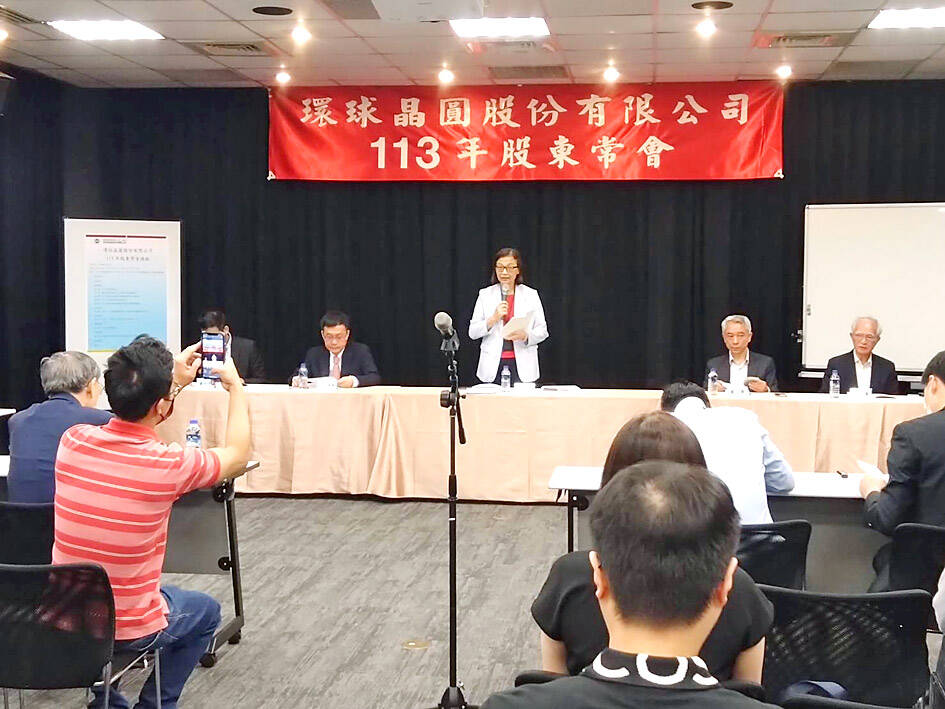GlobalWafers Co (環球晶圓), the world’s third-largest silicon wafer supplier, yesterday said revenue would increase at a much slower pace this year due to customers’ inventory adjustments and lackluster chip demand for smartphones, vehicles and industrial devices.
“The pickup in the second quarter was much weaker than we had thought,” GlobalWafers chairwoman Doris Hsu (徐秀蘭) told reporters following the firm’s annual general meeting. “We had expected a V-shape rebound, but that did not happen, and customers remain conservative about placing new orders due to high inventories.”
Another weak spot is the company’s compound semiconductor business — which includes the production of silicon carbide and gallium nitride chips — due to sagging electric vehicle demand and rapid growth in new capacity from China, Globalwafers said.

Photo: Grace Hung, Taipei Times
Revenue from the compound semiconductor business is expected to grow about 50 percent annually, rather than doubling or tripling as previously estimated, it said.
The only bright spots would be in artificial intelligence and high-performance computing applications, which propel demand for advanced memory chips such as high-bandwidth memory and DRAM chips, and in turn GlobalWafers’ advanced epitaxial wafers, it said.
The company said it anticipates better prospects next year, with customers’ inventory returning to healthy levels and PC replacement demand expected to stimulate chip consumption.
Separately, GlobalWafers said the EU Commission had issued an assignment decree awarding the firm’s Italian subsidiary MEMC Electronic Materials SpA a research-and-development grant of up to 103 million euros (US$110.4 million).
The Novara-based subsidy accounts for about 25 percent of the total investment of 420 million euros for the company’s planned 12-inch production facility in Italy.
“MEMC’s new fab will fill a critical gap in the European semiconductor supply chain that until now has been highly dependent on imports to supply wafers for the most advanced technology platforms,” GlobalWafers said.
The new plant would support the creation of downstream products, including sensors, logic applications, power and communications applications. It is set to ramp up production in the second half of next year, with an installed capacity of 100,000 wafers a month.
GlobalWafers expects the fab to help expand its market share in Europe from 30 percent currently, it said.
The investment is expected to create 600 construction jobs and 150 long-term company jobs, it added.

Taiwan Semiconductor Manufacturing Co (TSMC, 台積電) would not produce its most advanced technologies in the US next year, Minister of Economic Affairs J.W. Kuo (郭智輝) said yesterday. Kuo made the comment during an appearance at the legislature, hours after the chipmaker announced that it would invest an additional US$100 billion to expand its manufacturing operations in the US. Asked by Taiwan People’s Party Legislator-at-large Chang Chi-kai (張啟楷) if TSMC would allow its most advanced technologies, the yet-to-be-released 2-nanometer and 1.6-nanometer processes, to go to the US in the near term, Kuo denied it. TSMC recently opened its first US factory, which produces 4-nanometer

GREAT SUCCESS: Republican Senator Todd Young expressed surprise at Trump’s comments and said he expects the administration to keep the program running US lawmakers who helped secure billions of dollars in subsidies for domestic semiconductor manufacturing rejected US President Donald Trump’s call to revoke the 2022 CHIPS and Science Act, signaling that any repeal effort in the US Congress would fall short. US Senate Minority Leader Chuck Schumer, who negotiated the law, on Wednesday said that Trump’s demand would fail, while a top Republican proponent, US Senator Todd Young, expressed surprise at the president’s comments and said he expects the administration to keep the program running. The CHIPS Act is “essential for America leading the world in tech, leading the world in AI [artificial

REACTIONS: While most analysts were positive about TSMC’s investment, one said the US expansion could disrupt the company’s supply-demand balance Taiwan Semiconductor Manufacturing Co’s (TSMC, 台積電) new US$100 billion investment in the US would exert a positive effect on the chipmaker’s revenue in the medium term on the back of booming artificial intelligence (AI) chip demand from US chip designers, an International Data Corp (IDC) analyst said yesterday. “This is good for TSMC in terms of business expansion, as its major clients for advanced chips are US chip designers,” IDC senior semiconductor research manager Galen Zeng (曾冠瑋) said by telephone yesterday. “Besides, those US companies all consider supply chain resilience a business imperative,” Zeng said. That meant local supply would

Servers that might contain artificial intelligence (AI)-powering Nvidia Corp chips shipped from the US to Singapore ended up in Malaysia, but their actual final destination remains a mystery, Singaporean Minister for Home Affairs and Law K Shanmugam said yesterday. The US is cracking down on exports of advanced semiconductors to China, seeking to retain a competitive edge over the technology. However, Bloomberg News reported in late January that US officials were probing whether Chinese AI firm DeepSeek (深度求索) bought advanced Nvidia semiconductors through third parties in Singapore, skirting Washington’s restrictions. Shanmugam said the route of the chips emerged in the course of an